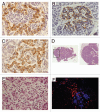Insulitis in human type 1 diabetes: The quest for an elusive lesion
- PMID: 21606672
- PMCID: PMC3154446
- DOI: 10.4161/isl.3.4.15728
Insulitis in human type 1 diabetes: The quest for an elusive lesion
Abstract
The histopathology of type 1 diabetes is defined by a decreased β-cell mass in association with insulitis, a characteristic lymphocytic infiltration limited to the islets of Langerhans and prominent in early stage disease in children. A cytotoxic T-cell mediated destruction of insulin-producing β-cells is thought to be initiated by an unknown (auto)antigen, leading to the destruction > 75% of β-cell mass at clinical diagnosis. Although considered to be pathognomonic for recent onset disease, insulitis has only been described in approximately 150 cases over the past century. This review describes the quest for this elusive lesion and gives its incidence in various patient subpopulations stratified for age of onset and duration of the disease. It discusses recent new insights into the regenerative capacity of the β-cell mass in the pre-clinical stages of the disease and relates these findings to the inflammatory processes within the islet tissue.
Figures

References
-
- Schmidt MB. Ueber die beziehung der langenhans'schen inseln des pankreas zum diabetes mellitus. München Med Wochenschr. 1902;49:51–54. (Ger).
-
- Von Meyenburg M. Ueber “Insulitis” bei Diabetes. Schweiz Med Wochenschr. 1940;21:554–557. (Ger).
-
- Gale EAM. The discovery of type 1 Diabetes. Diabetes. 2001;50:217–226. - PubMed
-
- Eizirik DL, Colli ML, Ortis F. The role of inflammation in insulitis and beta cell loss in type 1 diabetes. Nature Reviews. 2009;5:219–526. - PubMed
Publication types
MeSH terms
LinkOut - more resources
Full Text Sources
Other Literature Sources
Medical
Miscellaneous
